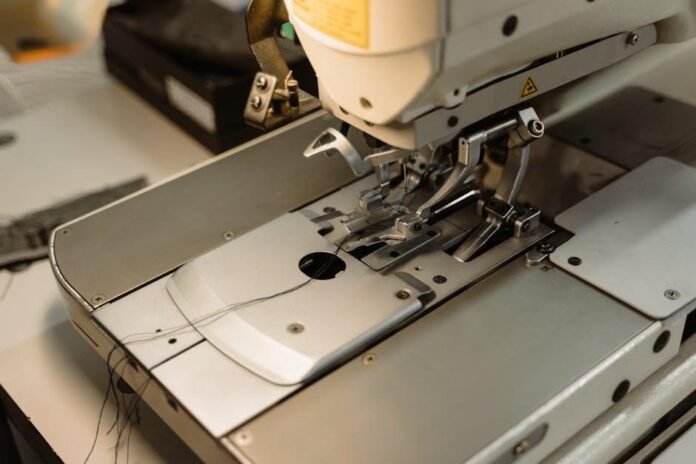Sewing Machine Maintenance Tips Every Crafter Should Know
In the realm of crafting, the sewing machine stands as a steadfast companion, transforming fabric scraps into lovely creations with a simple press of a pedal. Like any trusted ally, however, it requires a bit of care and attention to keep performing at its best. Just as an artist sharpens their brushes or a chef nurtures their knives, so too must a crafter dedicate time to the maintenance of their sewing machine. Whether you’re a seasoned seamstress or a novice just embarking on your stitching journey, understanding the essential upkeep of your machine can be the difference between frustration and flawless sewing. In this article, we will explore essential maintenance tips that not only prolong the life of your sewing machine but also enhance your crafting experience, ensuring that each seam is as smooth as your creative flow. Grab your toolkit,and let’s dive into the world of sewing machine care!
Essential Routine Cleaning Practices for your Sewing Machine
To ensure your sewing machine operates at its best, routine cleaning is paramount. Dedicating some time after every few projects can significantly extend the life of your equipment. Start by carefully removing the needle plate and cleaning out any lint and thread bits that may have accumulated. This debris can impede the machine’s performance and potentially lead to costly repairs.Consider using a small brush specifically designed for sewing machines to reach those tight corners easily.
After clearing out any lint,it’s essential to lubricate the necessary parts of your machine. Refer to the manufacturer’s manual for guidance on where to apply oil, as over-lubricating can cause more harm than good.Additionally, regularly replace the needle, as a dull needle can lead to skipped stitches and tension issues. To keep all your sewing tools organized and ready for use, invest in a small storage container for essential supplies like needles, threads, and cleaning tools. Here are some important reminders for your maintenance routine:
- Schedule a thorough clean monthly
- Use high-quality thread to reduce lint buildup
- Check and replace any worn-out parts promptly

Understanding and Replacing sewing Machine Needles Effectively
Understanding the significance of sewing machine needles is essential for achieving optimal sewing results. needles vary in size and type, and using the right one can dramatically influence the quality of your work.universal needles are versatile for most fabrics, while ballpoint needles are ideal for knits, and sharps excel with delicate fabrics. Here’s a quick guide to help you identify when it’s time to replace your needle:
- Frequent Snapping: If your needle snaps often, it may be worn out or unsuitable for your fabric.
- Skipped Stitches: This might indicate that the needle is dull or damaged.
- Fabric Snags: Indications of a blunt or incorrect needle type can lead to unwanted damage.
Replacing sewing machine needles is a straightforward process that can enhance your sewing experience. Always turn off your machine before starting the replacement to prevent accidents. Use the appropriate tool to remove the old needle, usually located on the side of the machine. When inserting a new needle, ensure it’s seated properly and aligned according to the manufacturer’s instructions. To simplify this task, consider the following table that outlines the most common needle types and their uses:
| needle Type | Best For |
|---|---|
| Universal | General sewing on woven and knit fabrics |
| Ballpoint | Knits and stretch fabrics |
| Sharps | Lightweight and delicate fabrics |
| Jeans/Denim | Heavy fabrics like denim and canvas |
| Embroidery | Sophisticated designs and embellishments |

Troubleshooting Common Sewing Machine Issues
Sewing machines can occasionally throw a wrench into your crafting plans. if you find your fabric feeding unevenly or your stitches looking less than perfect, consider checking these common culprits:
- Thread Tensions: Ensure that the upper and lower thread tensions are properly adjusted. This can frequently enough resolve issues with loose or overly tight stitches.
- Needle Condition: A dull or damaged needle can lead to skipped stitches. Always use the correct needle type for your fabric and replace it regularly.
- Bobbin Issues: Check your bobbin placement and ensure it’s wound evenly. Incorrect loading can lead to thread jams and poor stitching quality.
If you’re still encountering problems,consider performing a quick maintenance check. Here are some steps to guide you:
- Clean the Machine: Dust and lint can accumulate, hindering performance. Regularly remove the throat plate to clean out any debris.
- Oil Mechanisms: Apply a drop of sewing machine oil on the indicated areas to keep the mechanisms running smoothly.
- Review the Manual: Refer to your sewing machine manual for specific troubleshooting tips and maintenance schedules tailored to your model.

Maximizing Longevity with Proper Storage Techniques
Taking care of your sewing machine is not just about cleaning and oiling; proper storage techniques play a crucial role in ensuring its longevity. To protect your machine from dust,dirt,and potential damage,consider investing in a quality sewing machine cover. This will guard against environmental factors that could impact its performance. Additionally, always store the machine in a dry place to prevent moisture accumulation, which can cause rusting in the metal parts.
Another vital aspect of storage involves managing the accessories associated with your machine. Keep needles, threads, and additional feet organized and easily accessible by using storage compartments or toolboxes. This not only saves you time while crafting but also minimizes the risk of losing essential components. To provide a clearer understanding of effective storage methods, here’s a simple table highlighting key tips:
| Storage Method | Benefit |
|---|---|
| Sewing Machine Cover | Protects against dust and scratches |
| Dry Storage Area | Prevents moisture damage |
| Organized Accessory box | Reduces component loss and damage |
In Conclusion
As we thread the final stitch of our exploration into sewing machine maintenance, it’s clear that caring for your trusty companion is just as vital as the creativity it helps unleash. By incorporating these essential tips into your crafting routine, you’ll not only extend the life of your machine but also enhance your sewing experience. Remember, a well-maintained machine is an enabler of your imagination—smoothly gliding through fabric, producing the masterpieces you envision. So, as you embark on your next creative journey, keep these maintenance practices close at hand. After all, with a little care and attention, your sewing machine will continue to be a reliable partner in stitching together the fabric of your dreams. Happy sewing!

